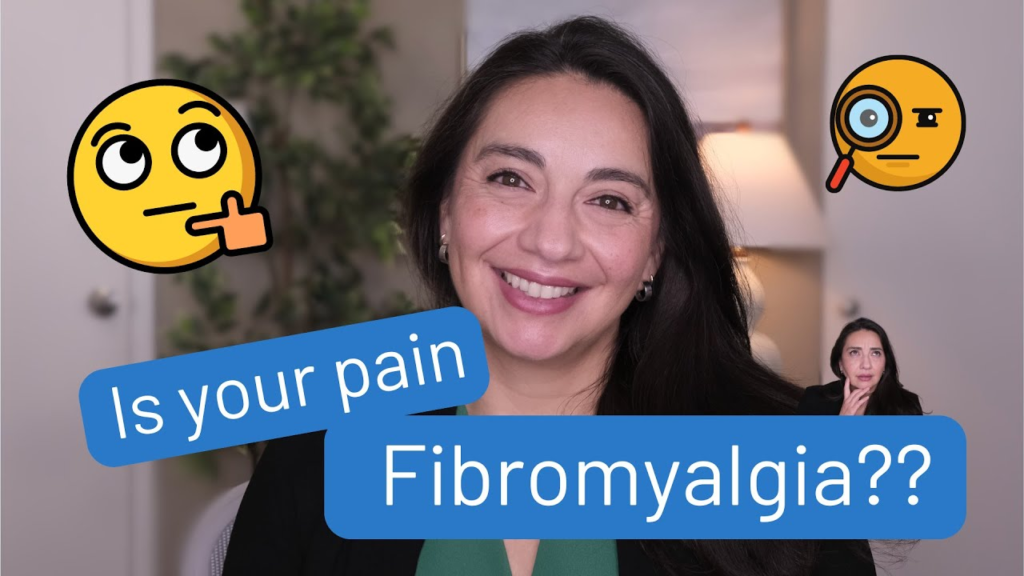
Pain Management
How to Stay Positive With Chronic Pain and Disease

In this short video, Jessica talks about staying positive with chronic pain and disease. Drawing on her experience as a physical therapist and also her personal experience with endometriosis and prolapse, Jessica gives the four tools she uses to stay positive. You can also listen to her podcast episode on this topic for more in-depth information about staying positive!
Chronic pain linked to socioeconomic background – new study

Development of chronic musculoskeletal pain can be influenced by socioeconomics, fear of movement, smoking and poorer support networks, new research shows.
In a systematic review of current evidence, researchers found that people from a lower socioeconomic background were twice as likely to develop chronic pain following injury.
Those with a combination of characteristics, including smoking, high level of pain at the time of injury, fear of movement, poorer support networks and a lower level of education or household income, maybe seven times more likely to develop chronic pain after an injury. The results are published in PLOS One.
Pain is described as ‘acute’ when it has been present for a short period of time – anything that lasts for less than three months after initial injury. Pain is described as chronic when it has been present for longer than three months after initial injury. Chronic musculoskeletal pain affects about 43 per cent of the UK population and is the greatest cause of disability worldwide, often persisting for many years or indefinitely. People with chronic pain often experience poorer quality of life and are also more likely to develop diseases including cancer, cardiovascular diseases and diabetes.
Current approaches to managing chronic pain focus on physical rehabilitation at the site of the pain, or injury. However, the body’s healing process usually takes place over no longer than three months, suggesting that the reasons for longer-term pain are more complex.
Lead author Michael Dunn, of the University of Birmingham and St. George’s University Hospitals NHS Foundation Trust, said: “The purpose of acute pain is to alter behaviour to protect the body from harm, but chronic pain persists because of a sensitised nervous system that continues our experience of pain, even after the healing process has completed.”
This process, the researchers found, is influenced by a range of psychological and social factors and so treatment which focuses solely on the injured body part is often ineffective.
Mr Dunn continued: “The characteristics that we have identified are related particularly to an individual’s experiences, rather than a type of injury. For that reason, approaches to treating people with musculoskeletal injuries should be more person-centred, focusing on broader biological, psychosocial and social well-being. Put simply, current healthcare approaches do not address all the reasons people do not get better.”
The researchers also identified other factors related to developing chronic pain, such as lower job satisfaction, stress and depression. These characteristics were supported by lower quality evidence, but are also linked to lower socioeconomic backgrounds.
“People from lower socioeconomic backgrounds are twice as likely to develop chronic pain after injury. This indicates that not only are current healthcare approaches inadequate, they may also be discriminatory, with current healthcare approaches that are orientated around the injured body part being geared towards those from higher socioeconomic backgrounds who are less likely to experience these psychological or social factors,” said Mr Dunn.
Why some people with rheumatoid arthritis have pain without inflammation
In this image, abnormal synovial tissue is shot through with excessive tissue growth, including blood vessels (in magenta). Synovium should be thin and smooth. CREDIT Bai et al.
Treatment for rheumatoid arthritis (RA) has come a long way in recent years. In many cases, a battery of medications can now successfully stymy the inflammatory cells that cause swelling and pain when they infiltrate tissues around the joints.
Yet for some reason, about 20% of patients with painful, visibly swollen joints consistently get no relief from multiple rounds of even the strongest of these anti-inflammatory drugs.
Surgical interventions intended to remove inflamed tissue have revealed why: “In some cases, their joints aren’t actually inflamed,” says co-senior author Dana Orange, an associate professor of clinical investigation in Rockefeller’s Laboratory of Molecular Neuro-oncology. “With these patients, if you press on the joint, it feels mushy and thick to the touch, but it’s not caused by the infiltrating immune cells. They have excessive tissue growth, but without inflammation. So why are they experiencing pain?”
She and her colleagues suggest an explanation in a new paper in Science Translational Medicine. These patients have a suite of 815 genes that activate abnormal growth of sensory neurons in tissues that cushion the affected joints.
“These 815 genes are rewiring the sensory nerves, which explains why anti-inflammatory drugs don’t work to alleviate pain for these patients,” says Orange. The findings may lead to new treatments for these outliers.
A puzzling disconnection
Rheumatoid arthritis is a tricky chronic disease. Its symptoms—stiffness, tenderness, swelling, limited motion, and pain—slowly emerge in the hands, wrists, feet, and other joints. It occurs symmetrically (not just in one hand but in both, for instance) and sporadically, with irregular flare-ups. Extreme fatigue and depression are also common.
Most cases of RA are caused by products of immune cells such as cytokines, bradykinins, or prostanoids invading the synovium—a soft tissue lining the joints—where they bind to damage-sensing pain receptors. Drugs that target immune mediators have made RA a far more tolerable condition for most, but those suffering from the disconnection between inflammation and ache haven’t benefitted.
Doctors often prescribe these patients drug after anti-inflammatory drug in an ultimately fruitless attempt to give relief. As a result, “we are subjecting some patients to a lot of medications that cause immunosuppression and yet have little chance of making their symptoms better,” Orange says.
She and her colleagues sought answers in the genes expressed in the joint tissue samples of these patients.
Genetic culprits
The researchers looked at tissue samples and self-reported pain reports from 39 patients with RA who had pain but little inflammation. They also developed a machine-learning analysis that they coined graph-based gene expression module identification (GbGMI).
GbGMI tests every possible combination of genes in a dataset to determine the optimal set of genes that together associate with a targeted clinical feature—in this case, pain.
Using RNA sequencing, the researchers found that of the 15,000 genes expressed in the tissue samples, about 2,200 had increased expression in the 39 patients. Using GbGMI, they identified 815 genes that together associated with patient reports of pain.
“This is a challenging problem, because we have a large number of genes but a limited number of patients,” says co-senior author Fei Wang, professor of population health sciences and founding director of the Institute of Artificial Intelligence for Digital Health at Weill Cornell Medicine. “The graph-based approach we used effectively explored the collective associations between a gene set and patient-reported pain.”
Single cell sequencing analysis found that of the four types of fibroblasts in synovial tissue, CD55+ fibroblasts exhibited the highest expression of pain-associated genes. Located in the outer synovial lining, CD55+ cells secrete synovial fluid, allowing for frictionless joint movement. They also expressed the NTN4 gene, which codes for a protein called Netrin-4. Proteins in the netrin family guide axon growth paths and promote new vascular growth.
Surprising pain pathways
These genes, it turned out, were enriched in pathways that are important for neuron axon growth, the researchers discovered. The keys to sensation, sensory neurons receive and transmit information to the central nervous system. Axons are the tendrils that branch out from them into tissues.
“That led us to hypothesize that perhaps the fibroblasts are producing things that alter the growth of sensory nerves,” Orange says.
But what role was the protein playing in the sensation of pain?
To find out, they grew neurons in vitro and then doused them with Netrin-4, which sparked the sprouting and branching of CGRP+ (gene-related peptide) pain receptors. It’s the first time that Netrin-4 has been shown to alter the growth of pain-sensitive neurons, she notes.
Imaging of RA synovial tissue also revealed an overabundance of blood vessels, which feed and nurture new cells. These vessels were encased by CGRP+ sensory nerve fibers and were growing towards the lining fibroblasts in areas of excessive tissue growth, or hyperplasia. This process likely leads to the squishy swelling that many rheumatologists and surgeons have mistaken for inflammation.
Better drugs
In the future, the researchers aim to home in on other products that fibroblasts may be producing that can affect the growth of pain-sensitive neurons. They’ll also delve into the other types of sensory nerves that might be affected.
“We studied one type, but there are about a dozen. We don’t know if all nerves are affected equally. And we don’t want to block all sensation. Sensory nerves are important for knowing that you should avoid certain movements and the position of your joint in space, for instance,” Orange says.
“We want to drill down on those details so that hopefully we can come up with other treatments for patients who don’t have a lot of inflammation. Right now, they’re taking medications that can cost $70,000 a year but have no chance of working. We must do a better job of getting the right drug to the right patient.”
How to tell if your pain is from Fibro – and how to talk to you doctor about it.

Are you or a loved one living with unexplained pain? In this enlightening episode, Dr. Elizabeth Ortiz breaks down the science behind Nociplastic pain and offers valuable insights to start the Fibro conversation with your doctor! Video Key Takeaways Fibromyalgia is a clinical syndrome characterized by widespread musculoskeletal pain, along with associated symptoms like fatigue, sleep disturbances, mood disorders, and brain fog. Fibromyalgia is a real condition with genuine pain.
The pain of fibromyalgia is termed “Nociplastic pain,” which results from a dysregulated nervous system, leading to hypersensitivity to pain signals. Fibromyalgia pain can manifest as deep, aching pain that is not logically connected to a specific injury, and it can occur on both sides of the body and above and below the waist. It’s essential to discuss the possibility of fibromyalgia with a doctor, explore medication options, and consider lifestyle changes such as diet, sleep, movement, and community support to manage fibromyalgia pain effectively.